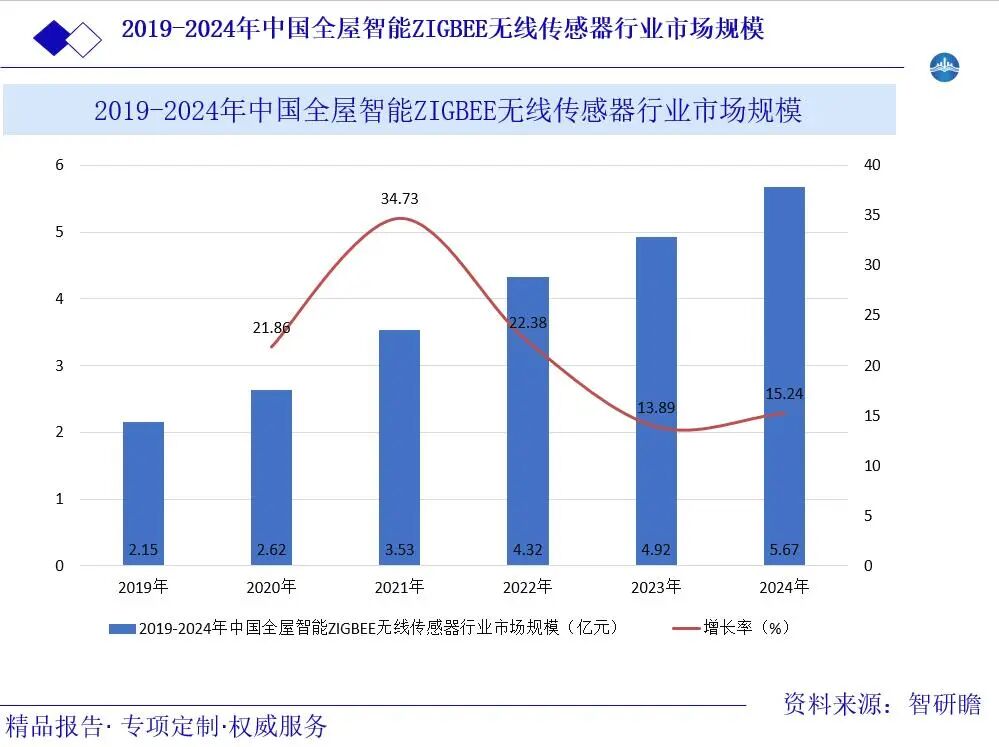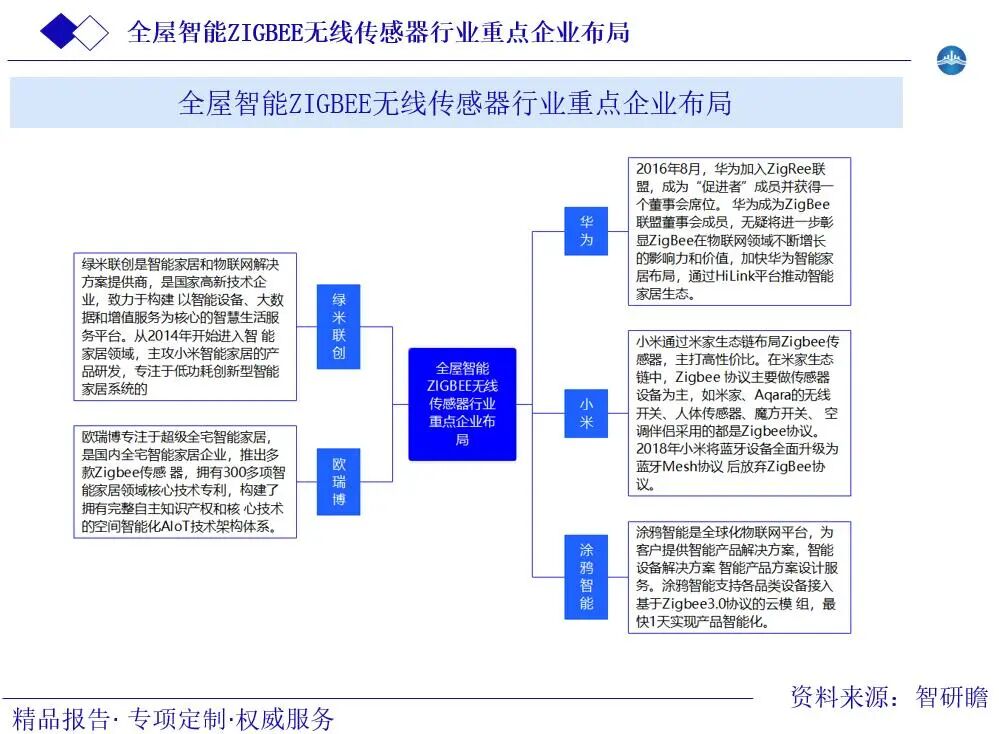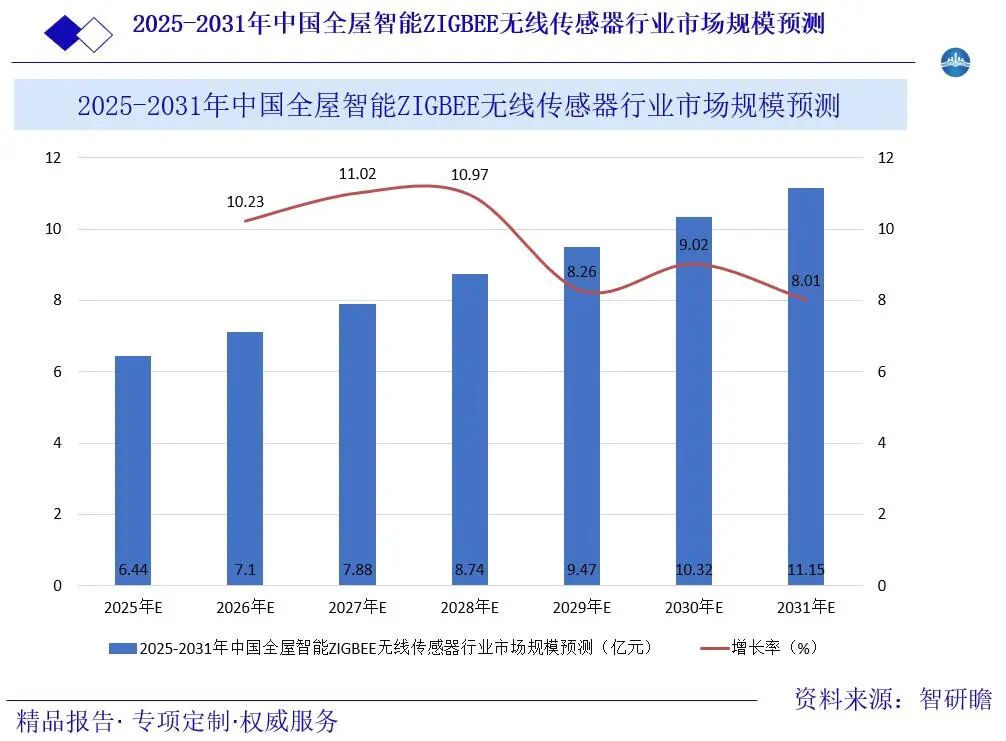Overview of the Whole House Intelligent ZigBee Sensor Industry
ZigBee, as a wireless network protocol, focuses on low-speed, short-distance data transmission. Its underlying architecture is strictly constructed according to the media access layer and physical layer defined in the IEEE802.15.4 standard. As a near-field wireless communication technology that has emerged in recent years, ZigBee technology has significant advantages such as low power consumption, low cost, and ease of application. Wireless networks built on ZigBee technology, due to their unique characteristics, have become an emerging technology that is highly compatible for building wireless sensor networks, and are increasingly gaining widespread attention.
Wireless sensor networks based on ZigBee show broad application prospects in both military and civilian fields, especially suitable for the following scenarios: first, when device costs are strictly limited and the amount of data to be transmitted is extremely limited; second, when devices are small and cannot accommodate larger batteries or power modules; third, in scenarios where there is insufficient power supply and can only rely on disposable batteries for operation; fourth, when frequent battery replacements or repeated charging operations are difficult or even impossible to implement; and fifth, in cases where monitoring or controlling a large communication coverage network is required. The main application areas of ZigBee technology include industrial control and monitoring (e.g., precise control of industrial equipment), home automation system construction, automotive control, agricultural automation production, and medical fields.
Overview of the Whole House Intelligent ZigBee Sensor Industry Chain
The structure of the whole house intelligent ZigBee wireless sensor industry is clear, with distinct upstream and downstream divisions. The upstream of the industry chain mainly includes the supply of various raw materials and components, including PCB circuit boards, chips, batteries, PC+ABS flame-retardant shells, and sensor modules. These raw materials and components are the foundation for constructing ZigBee wireless sensors, and their quality and performance directly affect the quality of the final product. The production process of ZigBee wireless sensors in the whole house intelligent space integrates and processes the raw materials and components provided by the upstream, manufacturing ZigBee wireless sensor products that meet the needs of different application scenarios through professional production processes and workflows. The downstream of the industry chain focuses on the application fields of the products, with ZigBee wireless sensors mainly applied in whole house intelligent devices and related solutions, providing key support for efficient and precise perception and control in home intelligence.

Image of the Whole House Intelligent ZigBee Wireless Sensor Industry Chain
Overview of the Development of the Whole House Intelligent ZigBee Sensor Industry
Wireless sensor networks, with their rapid deployment, self-organizing capabilities, good concealment, and ability to achieve unattended operation, demonstrate unique value in many fields. Against this backdrop, the ZigBee protocol, with its low cost, low power consumption, and ease of application, has emerged at the right time. This protocol has carefully constructed a universally applicable interconnection standard framework for wireless sensor networks and numerous microcontroller-based applications. With this framework, various related devices and applications can interact smoothly and operate collaboratively, greatly eliminating information silos and laying a solid foundation for the large-scale expansion of wireless sensor networks and related microcontroller applications. Its positive impact quickly radiates to related industries, effectively promoting the coordinated development of the upstream and downstream of the industry, making the entire industrial ecosystem increasingly prosperous and active, creating rare development opportunities for these applications and related industries, and helping them enter a fast track of rapid development.
As an emerging research field, wireless sensor networks mainly focus on real-time monitoring of the physical world, serving as a technical means dedicated to achieving precise monitoring objectives. Among them, ZigBee wireless communication technology stands out, showing particularly remarkable performance. It possesses powerful networking capabilities, allowing for the flexible construction of complex and diverse network topologies, achieving efficient and stable connections in star, tree, or mesh network layouts. At the same time, ZigBee technology also has an enormous network capacity, supporting a massive number of devices to connect to the network simultaneously, meeting the stringent requirements for the number of device connections in large-scale IoT application scenarios. This makes it widely applicable in various industries, including consumer electronics, home and building automation systems, industrial control, and medical devices. Given the unique performance of ZigBee wireless technology, it has become the preferred technical solution for wireless sensor networks, with extremely broad market prospects and development space in the future.
ZigBee wireless communication technology occupies a key position as one of the mainstream technologies in the whole house intelligent connection system, playing a crucial role in building intelligent home environments. The whole house intelligent ZigBee wireless sensors come in a variety of forms, including human body door/window sensors, temperature and humidity sensors, presence sensors, water immersion sensors, natural gas alarms, smoke alarms, and light sensors. These sensors perform their respective duties, enabling precise and real-time monitoring of key indicators such as human activity status, door/window opening and closing conditions, indoor temperature and humidity changes, water immersion risks, smoke concentration, and light intensity in home scenarios, providing critical data support for achieving intelligent and automated control of the home environment.
Market Scale of the Whole House Intelligent ZigBee Wireless Sensor Industry
Statistics show that in 2019, the market scale of China’s whole house intelligent ZigBee wireless sensor industry was 215 million yuan, and it is expected to reach 567 million yuan by 2024. The market scale of China’s whole house intelligent ZigBee wireless sensor industry is as follows:

Image of the Market Scale of China’s Whole House Intelligent ZigBee Wireless Sensor Industry from 2019 to 2024
Overview of the Layout of Enterprises in the Whole House Intelligent ZigBee Sensor Industry
The competitive landscape of China’s ZigBee wireless sensor industry is showing a heated state, with a diverse composition of market participants, mainly including three major camps: international enterprises, local enterprises, and startups. Each party presents differentiated competitive strategies and market positioning in the competitive landscape. International enterprises, with their deep technical accumulation and strong brand influence, occupy a significant advantage in the high-end market, attracting customers with strict performance and quality requirements with their advanced technology and high-quality products. Local enterprises leverage their cost control capabilities and advantages in building local ecosystems to actively expand market share, occupying a crucial position in the entire industry. Many startups are taking alternative paths, focusing on niche markets such as smart home and industrial IoT, continuously innovating and launching distinctive ZigBee sensor products, attempting to establish a foothold in the market and achieve rapid development. Among local enterprises, Huawei, Xiaomi, Tuya Smart, Orvibo, and Lumi United are prominent, becoming important forces driving industry development.

Image of Key Enterprises in the Whole House Intelligent ZigBee Wireless Sensor Industry Layout
Market Scale Forecast of the Whole House Intelligent ZigBee Wireless Sensor Industry
It is predicted that with the continuous growth of market demand for China’s whole house intelligent ZigBee wireless sensor industry, the market scale of this industry will show a steady upward trend from 2025 to 2031. By 2031, the market scale of China’s whole house intelligent ZigBee wireless sensor industry is expected to reach 1.115 billion yuan. The following is a detailed forecast of the market scale of China’s whole house intelligent ZigBee wireless sensor industry from 2025 to 2031:

Image of the Market Scale Forecast of China’s Whole House Intelligent ZigBee Wireless Sensor Industry from 2025 to 2031
Overview of the Development Trends of the Whole House Intelligent ZigBee Sensor Industry
In the current context of IoT and smart home applications, ZigBee technology occupies a crucial position and is one of the core practical technologies. It collaborates with technologies such as Wi-Fi and Bluetooth to create a diverse and rich wireless LAN technology system for the IoT.
The concept of smart home has undergone a long time span since its proposal. However, its development has long been sluggish, making slow progress on the road to widespread practical application. It was not until ZigBee technology emerged and gradually matured that this predicament is expected to usher in a turning point. It is anticipated that in the next two to three years, smart homes will accelerate their entry into thousands of households, deeply integrating into people’s daily lives. ZigBee modules have strong adaptability, easily installed in various products such as light bulbs, TV remote controls, air conditioning systems, access control systems, and various other household appliances. Through this module, intelligent control of home lighting, temperature and humidity regulation, security prevention, and electrical equipment management can be achieved, providing users with an unprecedented convenient experience.
From the perspective of industry development drivers, the trend of technological integration is becoming increasingly prominent, the level of intelligence continues to rise, and the market scale is constantly expanding. These factors together constitute a strong driving force for industry progress. At the same time, strong support from policy levels injects a shot of adrenaline into industry development. Against this backdrop, in such a macro environment and industrial development trend, China’s whole house intelligent ZigBee wireless sensor industry is seizing the significant opportunities brought by the rapid development of smart homes and the IoT, rising rapidly like a high-speed train. Looking ahead to future development trends, with the continuous rise of the intelligent wave, increasingly prominent personalized demands, and the widespread and deep penetration of green and environmental protection concepts throughout society, ZigBee sensors, with their unique technical advantages and performance characteristics, will further optimize user experience in the smart home field, achieving more efficient and intelligent interconnection between home devices; in the construction of smart buildings, they will help create a comprehensive and refined intelligent management system, enhancing the safety, convenience, and energy-saving levels of building operations; in the field of industrial IoT, they will provide precise and reliable data collection and transmission support for industrial production processes, promoting the transformation and upgrading of industrial manufacturing towards intelligence, automation, and greening. It is foreseeable that ZigBee sensors will fully unleash their powerful capabilities in the aforementioned fields, with the industry’s development prospects appearing extremely bright, containing infinite development potential and market opportunities.